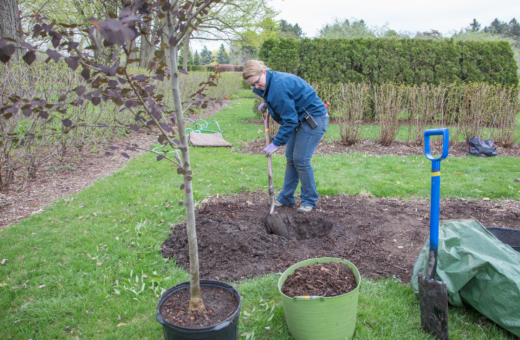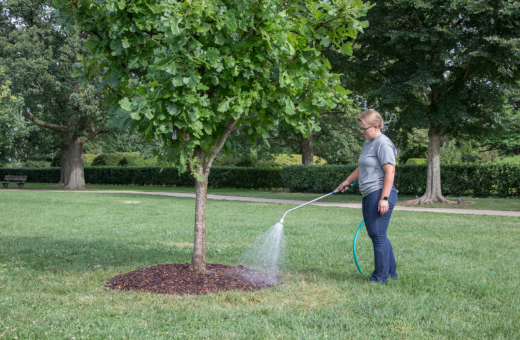August 23, 2023
The current heat wave is not the last we will see. “We’re getting more severe heat more often,” said Sharon Yiesla, plant knowledge specialist in the Plant Clinic at The Morton Arboretum. “It’s one of the ways our climate is changing.”
There are ways you can help your garden plants survive waves of heat in the 90s and above. Here are some tips from the Plant Clinic.
Water. Plants can only cool themselves by allowing water to evaporate from tiny holes in their leaves, but they need water in their leaves to do that. “Plants are 80 to 90 percent water,” Yiesla said. “All their life processes depend on it.”
Rainfall can supply some water, but don’t count on it. “Check that there is actually moisture several inches deep in the soil,” she said. “Sometimes rain just wets the surface but doesn’t penetrate down to where the roots can absorb it.”
Think ahead. Pay attention to the weather forecast, and if temperatures in the 90s are predicted, water thoroughly the day before. “Your plants will be much more resilient if they are already stoked up with water when the heat hits,” Yiesla said. There will also be a reservoir of moisture in the soil for the plants’ roots to draw on.
Don’t wait for plants to wilt as a signal to water. “Wilting means they’re already stressed,” she said. “You want to keep them from getting stressed in the first place.” If you do spot plants drooping or wilting, water them right away.
Mulch. A layer of mulch over the roots of your plants helps in two ways: It insulates the soil against extremes of temperature, and it prevents moisture from evaporating. You can apply mulch any time, so go ahead and spread it if you haven’t already.
Make a layer 1 to 2 inches deep on perennial beds and 3 to 4 inches around trees and shrubs. Spread the mulch out evenly, rather than piling it up against the trunk or stems. Try to keep mulch clear of the bark of a tree or shrub.
Water deeply. Rather than lightly sprinkling the soil surface, water long enough so that the moisture sinks several inches down. “In normal weather, wait several days before watering again,” Yiesla said. “In very hot weather, the plants may quickly use up the water in soil, so check to see if it’s dry and you should water more often.” Read
Expect some effects. In very hot weather, “plants are focused on surviving, not blooming or fruiting,” Yiesla said. Tomatoes, for example, won’t be pollinated or set fruit in temperatures over 90 degrees, and temperatures consistently in the 90s can prevent them from ripening. “Just keep watering to help them hang in there until days get a little cooler,” she said.
Water containers often. Soil is a plant’s moisture reservoir, and since pots don’t hold much soil, they dry out quickly. “In really hot weather you may need to water containers more than once a day,” Yiesla said.
New plants need extra help. Any trees, shrubs, or perennials that you installed this year will need even more watering. “New plants don’t have much of a root system, so they can’t absorb water as readily as established plants,” she said. Provide extra water for any trees or shrubs that you have planted in the last three years.
Help mature trees too. A day or two of temperatures in the 90s won’t faze a grand old shade tree. But in long periods of hot, dry weather, water your mature trees. “A big tree has tens of thousands of leaves, and they all need to be full of water to keep the tree cool and healthy,” Yiesla said. Apply water to as much of the root zone as you can—at least as far as the tree’s branches extend.
“You’ll be helping yourself too,” she said. “As water evaporates from tree leaves, it cools the air. And of course, there’s no better place on a hot day than the shade of a big tree.”



